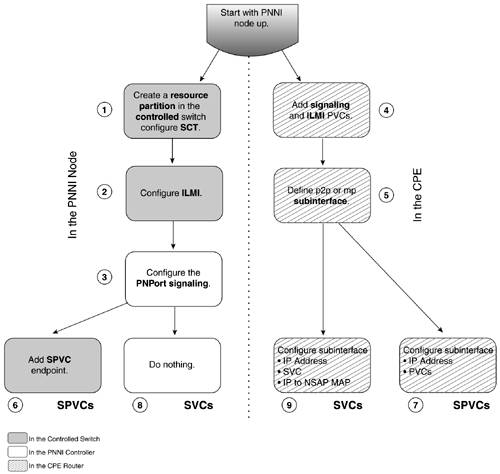Generic Configuration Model
| Before we dive into the configurations, this section provides a generic approach to PNNI configuration in multiservice switching networks. Different flow charts show the generic configuration steps. Near the end of this chapter, after each network element has been configured, the section "Summary of PNNI Configuration Commands" summarizes all the configuration commands in the different platforms. Generic PNNI Node BringupThe generic PNNI node bringup can be split into three main steps. Two of the three are performed in the controlled switch, and the remaining step is applied to the PNNI controller. A flow chart specifying these three steps is shown in Figure 10-3. Figure 10-3. Generic PNNI Node Bringup
In a SES-controlled BPX-8600 PNNI node, the first step includes upping and configuring a trunk, adding a resource partition, and configuring the port Service Class Template (SCT). The second step includes adding the SES as a feeder and a VSI controller. In MGX-8850 and MGX-8950 PNNI implementations, the first step is not performed because the PNNI controller is included in the PXM-45 software image, so there is no external interface to bring up. The PNNI configuration in Step 3, which is executed in the PNNI controller, is exactly the same in all platforms because PNNI software is the same among all multiservice switches. During this configuration step, the ATM address, the hierarchical level, the peer group ID, and the PGL designation are configured. They are particularly important in a PNNI multilevel scenario. Generic Link ConfigurationFigure 10-4 is a diagram for generic link bringup. Figure 10-4 is used for links connecting the PNNI node to both CPEs and PNNI neighbors. Figure 10-4. Generic Link Bringup
In Figure 10-4, Steps 1 through 3 are used for both UNI and PNNI link configuration. The configuration of Steps 1 and 2 is the same in both cases because you are configuring the controlled switch that is unaware of network protocols. Step 3, which is executed on the PNNI controller, selects the signaling to be used. Links facing CPEs use UNI signaling, and links toward PNNI neighbors use PNNI signaling and routing. PNNI configuration finishes on the third step, and CPE configuration continues in Steps 4 and 5. It is worth noting that MGX PNNI platforms need an extra initial stepconfiguring the card SCT. Card SCTs are not present in BXM VSI slaves. After Step 5 are two configuration paths, depending on the services provided. SPVCs are set up following Steps 6 and 7. SVCs are configured following Steps 8 and 9. |
EAN: 2147483647
Pages: 149

